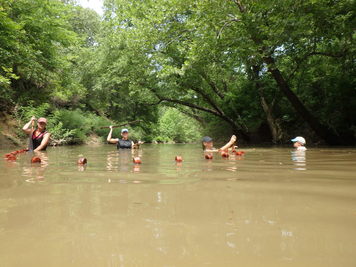 When you ask someone what they think when you say the word “summer” to them, most people will reply with no school, lemonade, late nights, swimming, fireworks, warm weather... When you ask a Blue Thumb team member what they think of, they’re probably going to say “fish collections.” July has been filled with fish collections with Blue Thumb staff, working mainly in the central part of the state in Oklahoma City and Norman, with a few collections taking place in the southeast, based on a rotating water basin schedule that happens every 4-5 years. What is happening on these fish collections? Why are they important? What are you seeing? While fishing days are long and hard, they are absolutely rewarding. Blue Thumb is out in rain or shine, cool or blistering heat, low flow or high flow performing these collections. They start in the morning with a habitat assessment of the creek, starting at a monitoring point and walking 400 meters downstream, stopping every 20 meters (called a transect) to take note of the habitat. This includes what substrate was in that transect, the depth and width of the stream at that transect, erosion, vegetation, and riparian area. This helps us better understand the creek and it’s health at a visual level, where we can go back and see how it has changed over the years, as well as assess the habitat that any fish might be utilizing. Once those 400 meters are finished, then the real fun begins. We start at the upstream site and use a seine to catch the fish. A seine is a specialized net that you pull through the water using 2 poles, and as you pull downstream, the frightened fish will swim upstream-straight into the net. After dragging it a few yards, the net is pulled up on a bank and the fish are counted by amount of individuals and number of species. It’s always fun to see what fish we catch, especially in these urban creeks where we assume pollution is prevalent. Fish like Longear, Bluegill and, Green sunfish, all manners of bass, carp and shads, are pollution tolerant. We’ve found quite a few of these fellows this year, which came as no surprise, and hasn’t differed from the past fish collections a few years ago. However, some true minnows, like the Suckermouth minnow, are moderately intolerant to pollution and habitat issues, and there have been a few urbanized creeks where we’ve found some. This is good news for the creek, since it means that the pollution level is decreasing enough for these critters to live happily. One thing that we’ve noticed in doing these collections, is that while each stream is different, the fish in them are also different. Sure, we’ve found mostly Longears and Greens and Bluegills in almost every creek, but because each stream is unique, the fish (though the same species), differ as well. The Bluegills in Crutcho Creek in OKC have much darker bands on them and are easier to tell apart from their Green and Longear counterparts. If you go a little ways out by Choctaw, the bands on the Bluegill are much lighter, and they sometimes look like Green sunfish. The Longears in OKC are much brighter with several arrays of colors on them, whereas the ones we’ve found in Norman aren’t quite as varied. Catfish size is different for every stream, and the bass vary in size and color everywhere. It can make things challenging when it comes to identifying them, but it’s fascinating to see and figure out these differences. Fish are a great way to determine the health of streams and creeks, just like bugs. Depending on the number of fish that are pollution tolerant or intolerant in a creek, we can assess the health of that stream. If we find a greater number of pollution tolerant species and little to no pollution intolerant fish, then we need to see what, exactly, is going on with the creek. On the other hand, it’s always good to see an increase of sensitive species over previous years.
0 Comments
Your comment will be posted after it is approved.
Leave a Reply. |
The Blue Thumb Blog
Archives
July 2018
Categories
|


 RSS Feed
RSS Feed